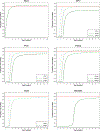Beyond coverage: Rural-urban disparities in the timeliness of childhood vaccinations in Tanzania
- PMID: 35961796
- PMCID: PMC9954535
- DOI: 10.1016/j.vaccine.2022.07.020
Beyond coverage: Rural-urban disparities in the timeliness of childhood vaccinations in Tanzania
Erratum in
-
Corrigendum to "Beyond coverage: Rural-urban disparities in the timeliness of childhood vaccinations in Tanzania" [Vaccine 40(37) (2022) 5483-5493].Vaccine. 2023 Mar 31;41(14):2425. doi: 10.1016/j.vaccine.2023.02.064. Epub 2023 Mar 6. Vaccine. 2023. PMID: 36889993 No abstract available.
Abstract
Background: Timely vaccination maximizes efficacy for preventing infectious diseases. In the absence of national vaccination registries, representative sample survey data hold vital information on vaccination coverage and timeliness. This study characterizes vaccination coverage and timeliness in Tanzania and provides an analytic template to inform contextually relevant interventions and evaluate immunization programs.
Methods: Cross-sectional data on 6,092 children under age 3 from the 2015-16 Tanzania Demographic and Health Survey were used to examine coverage and timeliness for 14 vaccine doses recommended in the first year of life. The Kaplan-Meier method was used to model time to vaccination. Cox proportional hazard models were used to examine factors associated with timely vaccination.
Results: Substantial rural-urban disparities in vaccination coverage and timeliness were observed for all vaccines. Across 14 recommended doses, documented coverage ranged from 52 % to 79 %. Median vaccination delays lasted up to 35 days; gaps were larger among rural than urban children and for later doses in vaccine series. Among rural children, median delays exceeded 35 days for the 3rd doses of the polio, pentavalent, and pneumococcal vaccines. Median delays among urban children were < 21 days for all doses. Among rural and urban children, lower maternal education and delivery at home were associated with increased risk of delayed vaccination. In rural settings, less household wealth and greater distance to a health facility were also associated with increased risk of delayed vaccination.
Discussion: This study highlights persistent gaps in uptake and timeliness of childhood vaccinations in Tanzania and substantial rural-urban disparities. While the results provide an informative situation assessment and outline strategies for identifying unvaccinated children, a national electronic registry is critical for comprehensive assessments of the performance of vaccination programs. The timeliness measure employed in this study-the amount of time children are un- or undervaccinated-may serve as a sensitive performance metric for these programs.
Keywords: Childhood vaccination; Demographic and Health Survey; Rural-urban disparities; Tanzania; Vaccination coverage; Vaccination timeliness.
Copyright © 2022 Elsevier Ltd. All rights reserved.
Conflict of interest statement
Declaration of Competing Interest The authors declare that they have no known competing financial interests or personal relationships that could have appeared to influence the work reported in this paper.
Figures

References
Publication types
MeSH terms
Substances
Grants and funding
LinkOut - more resources
Full Text Sources
Medical
Miscellaneous

